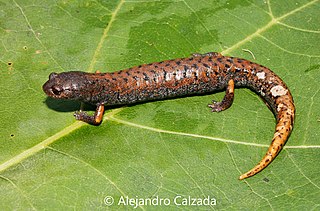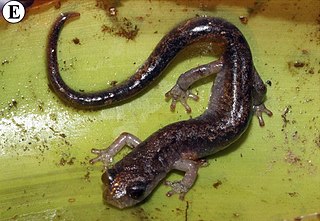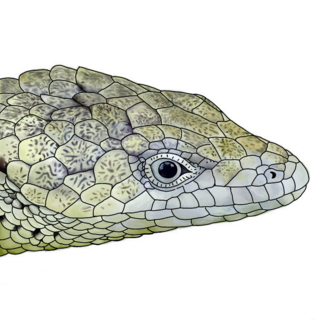
Abronia is a genus of lizards in the family Anguidae that is native to Mexico and Central America. The majority of the species are restricted to southern Mexico and Guatemala, but members of the genus occur as far south as Panama. They inhabit forests and woodlands, mostly in highlands, and some species are often associated with bromeliads. They are typically arboreal, but there are also terrestrial Abronia species. Many species are considered threatened due to habitat loss, killing by locals who mistakenly believe they are venomous, or collection for the captive reptile trade. They feed on small animal prey, such as insects, and the females give birth to live young.
Pseudoeurycea lineola, commonly known as the Veracruz worm salamander or Mexican slender salamander, is a species of salamander in the family Plethodontidae. It is endemic to the eastern slope of the Trans-Mexican Volcanic Belt near Cuautlapan, in the west-central Veracruz, Mexico, at elevations of 800–1,250 m (2,620–4,100 ft) above sea level. Molecular evidence suggests that it consists of two distinct species. It was the type species of genus Lineatriton.
Pseudoeurycea orchimelas, commonly known as the San Martin worm salamander, is a species of salamander in the family Plethodontidae. It is endemic to Veracruz, Mexico, where it is known from the Sierra de los Tuxtlas at elevations of 100–1,300 m (330–4,270 ft) above sea level.

Parvimolge is a genus of salamanders in the family Plethodontidae, the lungless salamanders. It is currently considered as monotypic, although this may yet change as molecular data suggest that it is embedded within a paraphyletic Pseudoeurycea. Parvimolge townsendi is endemic to the northern Sierra Madre de Oaxaca in central and southern Veracruz, Mexico, between 900 and 1900 meters elevation. It is represented by the species Parvimolge townsendi, commonly known as Townsend's dwarf salamander.

Pseudoeurycea is a genus of salamander in the family Plethodontidae. The members of this genus are commonly known as the false brook salamanders. They are found in Mexico and Guatemala.

Pseudoeurycea aurantia, commonly known as Peña Verde salamander, is a species of salamander in the family Plethodontidae. It is endemic to Oaxaca, Mexico and only known from its type locality near Peña Verde, which is the northernmost high peak in the Sierra de Juárez.
Pseudoeurycea firscheini is a species of salamander in the family Plethodontidae. It is endemic to the Sierra Madre de Oaxaca of west-central Veracruz, Mexico, and known from Acultzingo on the Puebla–Veracruz border eastward to the Sierra Zongolica. It is also known as the Firschein's false brook salamander or simply Firschein's salamander. The specific name firscheini honors Mr. Irwin Lester Firschein, an American biologist, geneticists, and anthropologist. The authors acknowledge Firschein for his explorations on Volcan San Martin, said to "have done much toward stimulating interest in this region of Mexico".

Pseudoeurycea juarezi is a species of salamander in the family Plethodontidae, endemic to Mexico.

Pseudoeurycea lynchi, commonly known as the Veracruz green salamander, is a species of salamanders in the family Plethodontidae.

Pseudoeurycea mystax is a species of salamander in the family Plethodontidae. It is endemic to Mexico and only known from the area of its type locality in the Sierra Madre de Oaxaca near Ayutla, Oaxaca. Its common name is mustache false brook salamander or mustached false brook salamander. The specific name refers to the whitish protuberances on the lips that resemble a mustache in the frontal view of the male holotype.
Isthmura naucampatepetl, commonly known as the Cofre de Perote salamander, is a species of salamanders in the family Plethodontidae. It is endemic to the Sierra Madre Oriental in central Veracruz, Mexico, where it is known from between Cofre de Perote and Cerro Volcancillo, a satellite peak of Cofre de Perote.
Aquiloeurycea praecellens, also known as the admirable false brook salamander, is a species of salamander in the family Plethodontidae. It is endemic to the Sierra Madre Oriental in Veracruz, Mexico. Its natural habitat is lowland tropical moist forest where it is threatened by habitat loss.
The Cuetzalan salamander is a species of salamander in the family Plethodontidae. It is endemic to the Sierra Madre Oriental in Puebla, Mexico. Its specific name refers to its type locality, Cuetzalan del Progreso. Its natural habitat is cloud forest, but it also occurs in coffee groves. It has been found in a range of micro-habitats, such as under moss in rock walls, under stones, inside and under rotten logs, and in leaf axils. It might be threatened by habitat loss caused by human settlements and tourist development.

Pseudoeurycea ruficauda, also known as the orange-tailed agile salamander, is a species of salamander in the family Plethodontidae. It is endemic to the Sierra Mazateca, a part of Sierra Madre de Oaxaca of Mexico. The specific name ruficauda derives from the Latin words rufous (=reddish) and cauda (=tail) and refers to the reddish orange tail of this salamander. P. jaguar is its closest relative.

Pseudoeurycea saltator is a species of salamander in the family Plethodontidae. It is endemic to Oaxaca, Mexico, and only known from the northern slopes of the Sierra de Juarez above Vista Hermosa.
Pseudoeurycea werleri is a species of salamander in the family Plethodontidae. Its common name is Werler's false brook salamander or simply Werler's salamander. It is endemic to the Sierra de los Tuxtlas range in southern Veracruz state, Mexico. Its natural habitats are tropical rainforests and cloud forests where it lives in moss mats. It is threatened by habitat loss caused by subsistence agriculture, logging, and human settlement.
Thorius, also known as minute salamanders, pigmy salamanders, or Mexican pigmy salamanders, is a genus of salamanders in the family Plethodontidae. They are endemic to Mexico and found in southern Veracruz and Puebla to Guerrero and Oaxaca.

Aquiloeurycea is a genus of salamanders in the family Plethodontidae. They are endemic to Mexico. The genus corresponds to the former "Pseudoeurycea cephalica species group", which was established in order to preserve Ixalotriton and Bolitoglossa while avoiding paraphyly of Pseudoeurycea.

Isthmura is a genus of salamanders in the family Plethodontidae. They are endemic to Mexico. The genus, which corresponds to the former "Pseudoeurycea bellii species group" and was first described as a subgenus of Pseudoeurycea, was raised to full generic level in 2015 in order to preserve Ixalotriton and Bolitoglossa while avoiding paraphyly of Pseudoeurycea.

Abronia zongolica is a species of lizard in the family Anguidae. The species is endemic to Mexico. It is known from mature pine-oak forests at elevations of 1,500–2,200 m (4,900–7,200 ft) above sea level in the eponymous Sierra de Zongolica, Veracruz.











